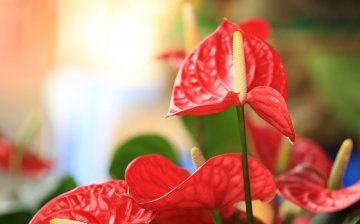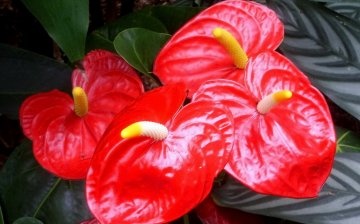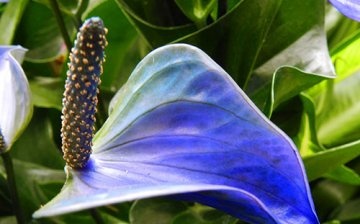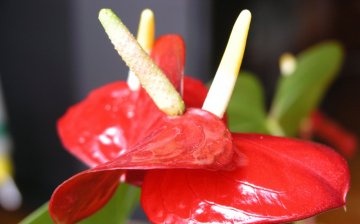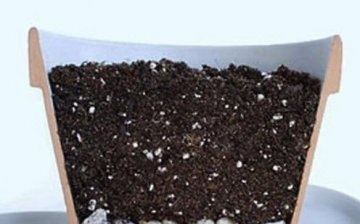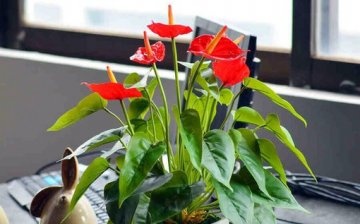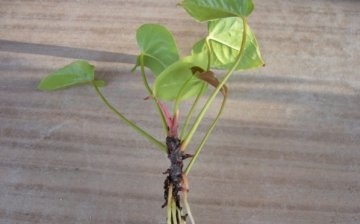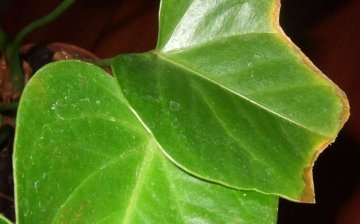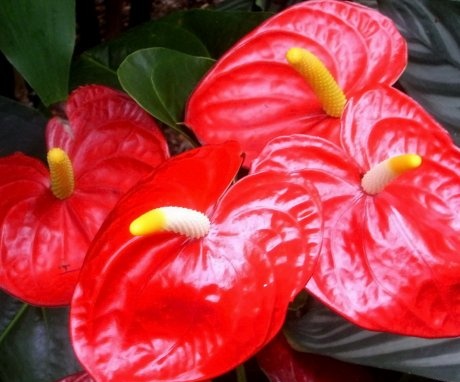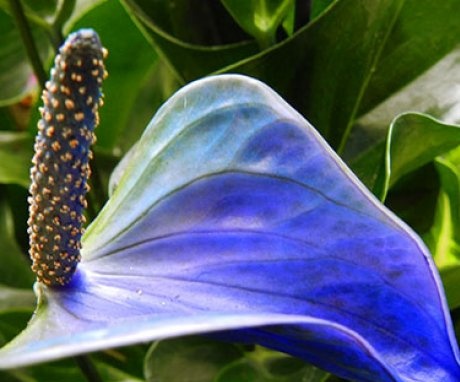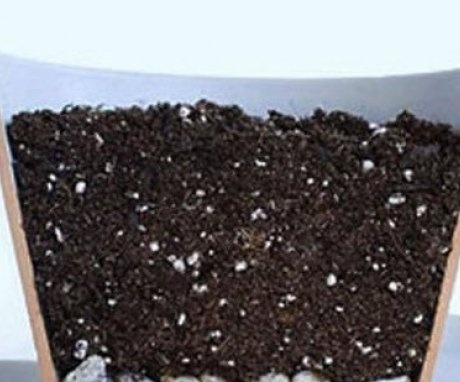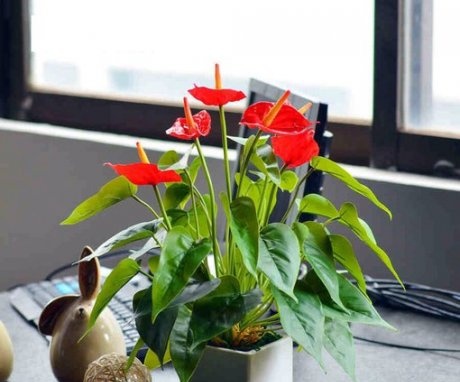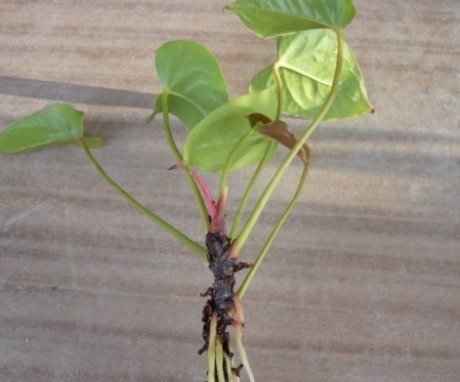Features of growing anthurium at home
Flowers of a fiery or sky blue hue attract the eyes, delight and make you run to the flower shop to buy this beauty for growing. Anthurium rightfully occupies a leading place among ornamental plants. Its unearthly beauty appearance, bright shades and shiny, luscious green leaves decorate the interior of the room, cheer up.
To grow anthurium it is not easy at home, it is a capricious flower that does not tolerate blemishes in care. Before purchasing a stalk or a ready-made anthurium bush, you should familiarize yourself with the features and nuances in the care, planting and growing of a plant.
Content:
- Features of the structure of anthurium
- Types of anthurium
- Growing conditions
- Planting rules: soil preparation
- We take care of the anthurium correctly
- Reproduction methods
- Diseases and pests
Features of the structure of anthurium
Anthurium is not like other ornamental plants, its unusual leaves and flowers are the main distinguishing feature:
- Anthurium is a small shrub up to 1 m in height in the wild and 50-60 cm in culture.
- The plant has gorgeous foliage of various shapes - carved, oval, heart-shaped, elongated.
- Leaves are leathery, dense, shiny, juicy green. Some species have veins of a contrasting color, light or silvery against the general green background of the leaf.
- Root system anthurium superficial.
- Anthuriums bloom almost all year round. Flowers are cob, inflorescences are densely arranged and have a square shape.
- The ear rises above the veil, a heart-shaped leaf that surrounds the inflorescence.
- The bedspread has a bright color, the shades of which vary from fiery red, yellow, green, blue to pink or purple, black.
Anthurium grows wild in southern Brazil, North America, Paraguay, Mexico, the Antilles and northern Argentina. Belongs to the Aroid family and has about 900 species. Grows in the form of a bush, vines or grass.
Another name for the plant is "flamingo flower".
According to legends, anthurium gives strength to the strong half of humanity and is considered a male flower for this reason. In phytodesign, anthurium is used quite widely, despite its finickyness. More often the plant is grown in greenhouses and conservatories. Breeding anthurium at home is a real challenge for a florist, especially when it comes to an apartment.
Types of anthurium
The successful cultivation of the southern handsome directly depends on the species and variety chosen by the gardener. There are plants that are almost impossible to breed at home, but there are those specially designed for this. Therefore, it is important to understand the cultural types of anthurium.
At home, you can safely plant a species called "flowering". It includes the following varieties:
- "Scherzer" - the unusual foliage of the plant attracts attention. Specks or dots appear on the dark general background of the leaf. Leaves are dense, leathery, shiny. The shoots of the plant are shortened, underground shoots are notable for the variety. The inflorescence is bright, yellow in the form of a cob.Anthurium Scherzer reaches a height of 50-60 cm.
- "Andre" - the leaves of this variety of flowering anthurium are oval, shiny, leathery, juicy green. The cob-shaped inflorescence is white with a bright red, fiery veil. The plant reaches a height of 70-90 cm, depending on the conditions of detention.
Hybrids of this type of anthurium have different shades of bedspreads - pink, blue, purple or even green. At home, you can also grow the "liana" species. Popular varieties of this species:
- "Majestic" is a very showy plant with leaves decorated with light, olive-colored veins. The greens are large, sinewy, of a dark green hue. Grown due to the decorativeness of the leaves.
- "Crystal" - this anthurium is interesting for the color of the leaves. The young plant has a purple hue, but with age it changes to a dark green. The veins of the plant are silvery, it looks very beautiful.
Beautifully flowering and liana-like types of anthurium will delight the owner of the house, they can adapt to the conditions of the apartment, provided they are properly cared for. Most often choose the variety "Andre" because of the bright color of the bedspread and its variety.
Growing conditions
Anthurium loves warm and humid habitats. Growing conditions should be as close as possible to the microclimate of tropical forests. The lighting is bright, diffused. Direct sunlight should not fall on the anthurium, otherwise it will get sick. In the apartment, select the western or eastern direction of the window. Anthurium can survive partial shade, that is, place the flowerpot away from the window. So direct sunlight will not fall on it, and radiators in winter will not dry out the plant.
The air temperature in summer should be 22 ° -25 °, in winter - at least 18 °.
The soil should be light, slightly acidic with good drainage. Air and moisture must penetrate well into the ground. Some types of anthurium like bark and wood ash in the soil. Experienced growers advise adding these ingredients to the substrate.
Indoor humidity is also important - 70% -85%. If the indicator is lower or higher, the plant begins to hurt. Compliance with this condition is mandatory. Dry air in an apartment in winter must be "humidified" with the help of special equipment or by spraying with water. Compliance with the growing conditions will be the key to the successful growth and development of anthurium. It will bloom almost the whole year, diseases will not strike him, but pests are unlikely to appear.
Planting rules: soil preparation
Before purchasing a ready-made anthurium bush, you need to prepare the soil for it and choose a flowerpot:
- The container is selected small, shallow and, preferably, transparent. That is, you can choose a pot for both orchids... It must have holes in the bottom and a pallet.
- The substrate is prepared from leafy earth, peat, sand and humus. The ratio is 1: 1: 0.5: 2. It is advisable to add charcoal to the soil. Broken brick or expanded clay is poured onto the bottom of the container as drainage. Many people add pieces of bark or cones of spruce crops to the soil.
A purchased bush is immediately transplanted into fresh soil and a new flowerpot. Cuttings or the seeds planted in spring for germination. It should be noted that seeds germinate for a very long time. Right after transplants the plant is monitored and ensured care.
We take care of the anthurium correctly
Proper care is the key to a healthy and beautiful plant. Anthurium is capricious, does not tolerate drafts and temperature changes. Any deviation from the prescribed temperature or humidity can lead to illness.
Watering:
- Anthurium must be constantly watered with warm, settled water.
- Abundant watering recommended during flowering - in summer.
- The soil should always be moist, but not soggy and waterlogged.
- During the rest period, anthurium is watered less often.
- In the summer, a sprinkling or spraying procedure is carried out every 5 days.
- The air around the flower is constantly humidified. It is important not to allow the earthen coma to overflow or dry.
Top dressing is carried out every three weeks in complexes mineral fertilizers or organic... Active application in summer, stop feeding in winter. It is important not to overdo it with nitrogen complexes. Anthurium responds well to organics. The first fertilization is carried out immediately after landing, a break for two weeks and re-introduction. Then they are fed every 3 weeks until October.
A young anthurium is transplanted every year in the spring, and an adult plant every 2-3 years.
If it can be seen that the roots have entangled the entire earthen lump, anthurium can be transplanted at other times of the year. Rooted cuttings are transplanted in the spring. Transfer is needed not only for the plant to have enough space for growth, but also for the enrichment of the soil. The soil is quickly depleted. This can lead to poor flowering or stunted growth.
Reproduction methods
Anthurium is propagated using dividing the bush, apical cuttings, seed and side shoots. The latter are taken in the case of the formation of aerial roots on them.
Cuttings are rooted in a substrate prepared for them or in a wet drainage - expanded clay.
Anthurium seeds are propagated very rarely. This is a delicate matter and requires patience. To obtain seeds, the plant is artificially pollinated and fruits are expected to appear - up to 12 months. Each berry produces from 2 to 5 seeds.
Whichever breeding method is chosen, the grower needs to be patient and take care of the cuttings or shoots.
Diseases and pests
The most common disease of anthurium is anthracnose. The leaves dry out at the edges and die off. If you do nothing, the plant may die. As soon as you find characteristic spots, immediately remove the leaves and treat them. fungicides... A neglected disease is difficult to cure.
Scabbard, spider mite and aphids... The parasites are removed with a cotton pad moistened with soapy water. The plant is sprayed with soapy water; in case of severe damage, it is worth resorting to insecticides, for example, "Actellik".
It is almost impossible to protect yourself from pests, since they love exactly the environment in which anthurium develops - heat and humidity.
The main thing is to stop the activity of both parasites and fungal diseases in time. The fact is that the prevention of the appearance of pests and anthracosis consists in the systematic ventilation of the room, which anthurium does not like. If you make a draft, he may die. But the degree of waterlogging can be prevented. Make sure the soil is moderately moist, not soggy.
Proper care, timely transfer, optimal growing conditions will help to grow healthy, strong and abundantly flowering anthurium. Do not be lazy, take care of the capricious plant and everything will work out!
More information can be found in the video:



